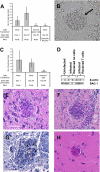Removal of Toxoplasma gondii cysts from the brain by perforin-mediated activity of CD8+ T cells
- PMID: 20167872
- PMCID: PMC2843452
- DOI: 10.2353/ajpath.2010.090825
Removal of Toxoplasma gondii cysts from the brain by perforin-mediated activity of CD8+ T cells
Abstract
Chronic infection with Toxoplasma gondii is one of the most common parasitic infections in humans. Formation of tissue cysts is the basis of persistence of the parasite in infected hosts, and this cyst stage has generally been regarded as untouchable. Here we provide the first evidence that the immune system can eliminate T. gondii cysts from the brains of infected hosts when immune T cells are transferred into infected immunodeficient animals that have already developed large numbers of cysts. This T cell-mediated immune process was associated with accumulation of microglia and macrophages around tissue cysts. CD8(+) immune T cells possess a potent activity to remove the cysts. The initiation of this process by CD8(+) T cells does not require their production of interferon-gamma, the major mediator to prevent proliferation of tachyzoites during acute infection, but does require perforin. These results suggest that CD8(+) T cells induce elimination of T. gondii cysts through their perforin-mediated cytotoxic activity. Our findings provide a new mechanism of the immune system to fight against chronic infection with T. gondii and suggest a possibility of developing a novel vaccine to eliminate cysts from patients with chronic infection and to prevent the establishment of chronic infection after a newly acquired infection.
Figures


Similar articles
-
The immune system utilizes two distinct effector mechanisms of T cells depending on two different life cycle stages of a single pathogen, Toxoplasma gondii, to control its cerebral infection.Parasitol Int. 2020 Jun;76:102030. doi: 10.1016/j.parint.2019.102030. Epub 2019 Nov 25. Parasitol Int. 2020. PMID: 31778800 Free PMC article. Review.
-
Selective Upregulation of Transcripts for Six Molecules Related to T Cell Costimulation and Phagocyte Recruitment and Activation among 734 Immunity-Related Genes in the Brain during Perforin-Dependent, CD8+ T Cell-Mediated Elimination of Toxoplasma gondii Cysts.mSystems. 2020 Apr 14;5(2):e00189-20. doi: 10.1128/mSystems.00189-20. mSystems. 2020. PMID: 32291349 Free PMC article.
-
Inducible nitric oxide synthase in innate immune cells is important for restricting cyst formation of Toxoplasma gondii in the brain but not required for the protective immune process to remove the cysts.Microbes Infect. 2018 Apr;20(4):261-266. doi: 10.1016/j.micinf.2017.12.004. Epub 2017 Dec 26. Microbes Infect. 2018. PMID: 29287983 Free PMC article.
-
Interferon-gamma- and perforin-mediated immune responses for resistance against Toxoplasma gondii in the brain.Expert Rev Mol Med. 2011 Oct 4;13:e31. doi: 10.1017/S1462399411002018. Expert Rev Mol Med. 2011. PMID: 22005272 Free PMC article. Review.
-
Determination of a Key Antigen for Immunological Intervention To Target the Latent Stage of Toxoplasma gondii.J Immunol. 2017 Jun 1;198(11):4425-4434. doi: 10.4049/jimmunol.1700062. Epub 2017 Apr 26. J Immunol. 2017. PMID: 28446567 Free PMC article.
Cited by
-
Toxoplasma gondii antigens recognized by IgG antibodies differ between mice with and without active proliferation of tachyzoites in the brain during the chronic stage of infection.Infect Immun. 2012 Oct;80(10):3611-20. doi: 10.1128/IAI.00604-12. Epub 2012 Jul 30. Infect Immun. 2012. PMID: 22851753 Free PMC article.
-
The protein kinase double-stranded RNA-dependent (PKR) enhances protection against disease cause by a non-viral pathogen.PLoS Pathog. 2013;9(8):e1003557. doi: 10.1371/journal.ppat.1003557. Epub 2013 Aug 22. PLoS Pathog. 2013. PMID: 23990781 Free PMC article.
-
PD-L1, TIM-3, and CTLA-4 Blockade Fails To Promote Resistance to Secondary Infection with Virulent Strains of Toxoplasma gondii.Infect Immun. 2018 Aug 22;86(9):e00459-18. doi: 10.1128/IAI.00459-18. Print 2018 Sep. Infect Immun. 2018. PMID: 29967089 Free PMC article.
-
Complex immune cell interplay in the gamma interferon response during Toxoplasma gondii infection.Infect Immun. 2014 Aug;82(8):3090-7. doi: 10.1128/IAI.01722-14. Epub 2014 May 27. Infect Immun. 2014. PMID: 24866795 Free PMC article. Review.
-
[Toxoplasma gondii-Current drugs and future vaccines against an underestimated protozoan infection].Internist (Berl). 2021 Oct;62(10):1123-1132. doi: 10.1007/s00108-021-01155-1. Epub 2021 Aug 31. Internist (Berl). 2021. PMID: 34467425 Review. German.
References
-
- McCabe RE, Remington JS. Toxoplasma gondii. Mandell GL, Douglas RG, Bennett JE, editors. New York,: Churchill Livingstone Inc.,; 1990:p. 2090–2103.
-
- Israelski DM, Remington JS. Toxoplasmosis in the non-AIDS immunocompromised host. Remington JS, Swrltz M, editors. London,: Blackwell Scientific Publications,; 1993:pp. 322–356. - PubMed
-
- Wong SY, Remington JS. Toxoplasmosis in the setting of AIDS. Broder S, Merga TC Jr, Bolognesi D, editors. Baltimore,: Williams & Wilkins,; 1994:pp. 223–257.
-
- Yazar S, Arman F, Yalcin S, Demirtas F, Yaman O, Sahin I. Investigation of probable relationship between Toxoplasma gondii and cryptogenic epilepsy. Seizure. 2003;12:107–109. - PubMed
Publication types
MeSH terms
Substances
Grants and funding
LinkOut - more resources
Full Text Sources
Research Materials

